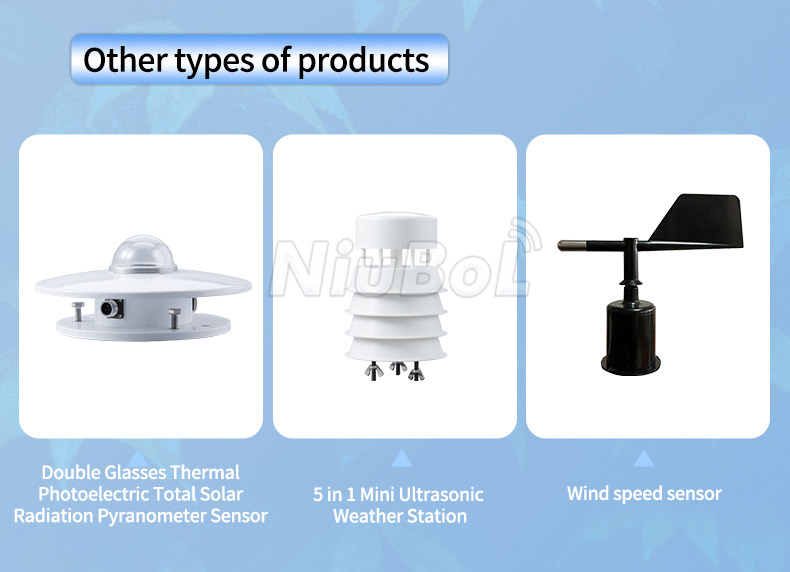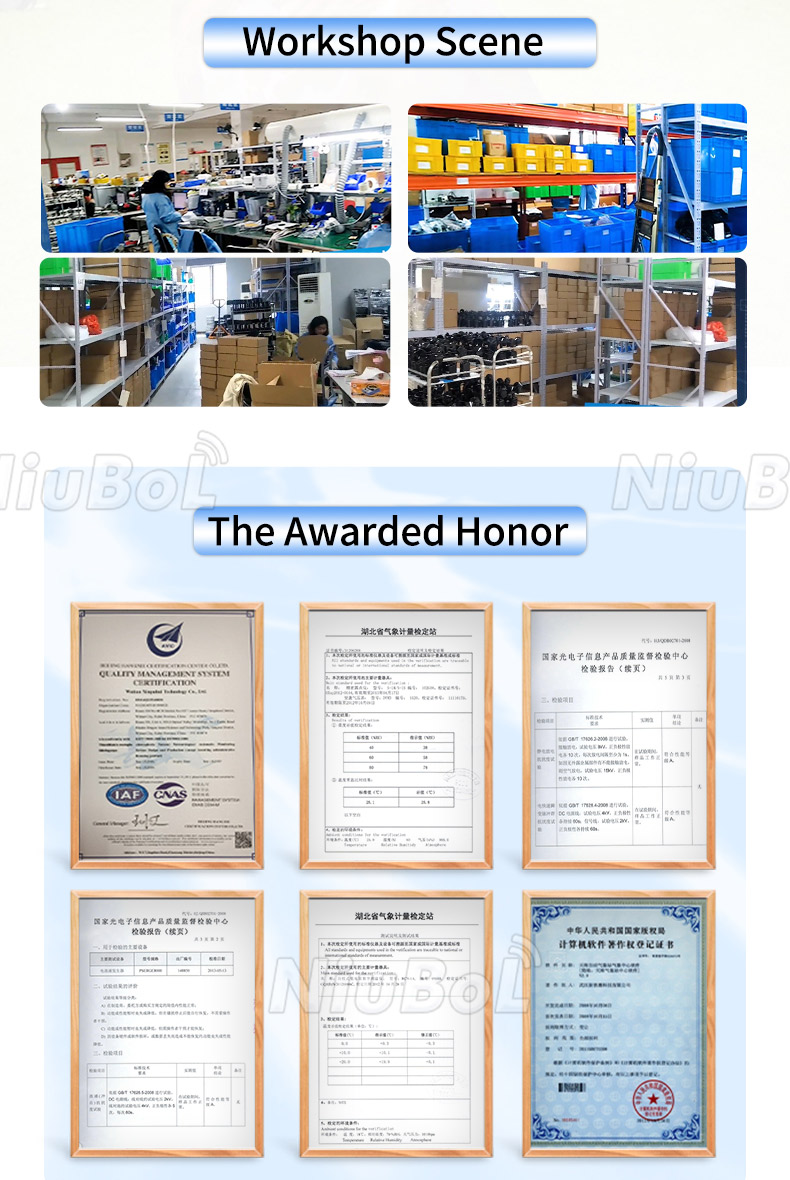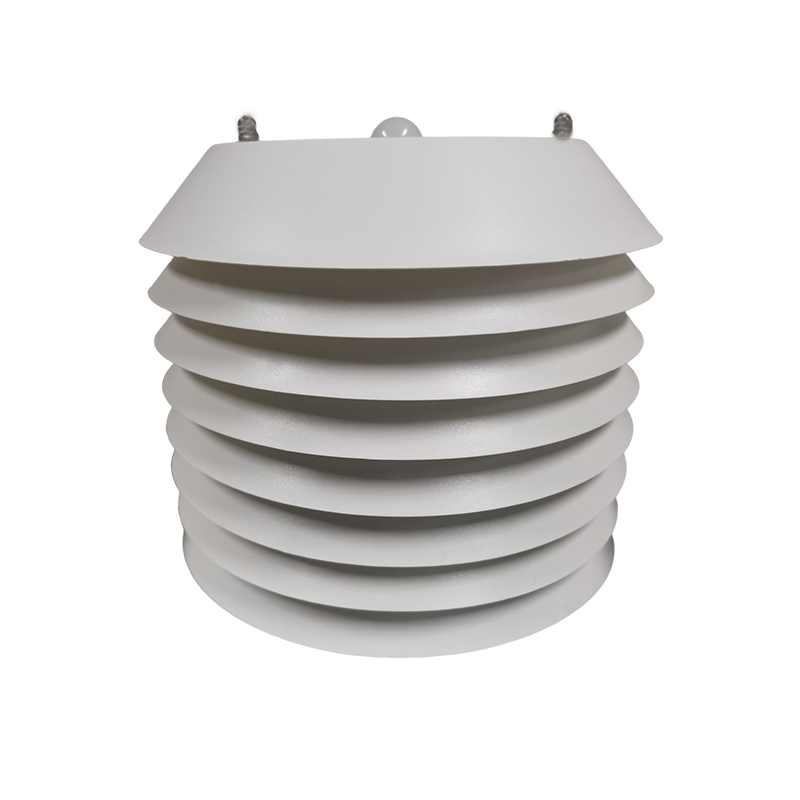

— Products —
 Consumer hotline +8618073152920
Consumer hotline +8618073152920 WhatsApp:+8615367865107
Address:Room 102, District D, Houhu Industrial Park, Yuelu District, Changsha City, Hunan Province, China
Weather Stations
The Solar Radiation Sensor( Pyranometer) is used to measure the total solar radiation in the spectral range of 0.3-3μm, and can also be used to measure the solar radiation incident to the oblique surface, such as induction face down can measure the reflected radiation, such as adding a shading ring can measure the scattered radiation. Therefore, it can be widely used in solar energy utilization, meteorology, agriculture, building materials aging and atmospheric pollution and···
Tel/WhatsApp:+8615367865107
Email:Arvin@niubol.com +Nearly 100 partner company in more than 68 countries. We are committed to providing high-quality, practical products to meet your needs and help you solve problems.Product Details
The pyranometer, derived from the Greek words “pyr” (meaning fire or sun) and “-ometer” (measuring instrument), is a sophisticated meteorological instrument designed to measure the total solar radiation received at the Earth's surface. The instrument is designed to capture the sum of direct and scattered solar radiation from the entire sky down to the horizontal plane, thus providing accurate data on the intensity of solar radiation. It plays a vital role in the fields of atmospheric science, solar engineering, climate research, and building design.

The device usually consists of a sensing element sensitive to solar radiation, which is encased in a transparent domed protective case to protect it from rain and dust while ensuring free incidence of radiation. The sensing element converts the received radiant energy into an electrical signal that can be recorded and analyzed by electronic devices.The Pyranometer measures in watts per square meter (W/m²), which is in accordance with the International System of Units and allows for easy comparison and application of data on a global scale.
Pyranometer data is critical in the design and optimization of solar power systems, helping engineers assess potential solar output and adjust the layout of photovoltaic panels to maximize energy capture. Additionally, in agrometeorology, monitoring solar insolation can help farmers develop irrigation and crop planting strategies. Climate change researchers also rely on long-term Pyranometer observations to understand how solar radiation affects the Earth's energy balance and climate patterns.







Solar Radiation Sensor( Pyranometer) adopts the principle of thermoelectric induction and works with various radiation recorders or radiation ammeters to accurately measure TBQ total radiation, reflected radiation, scattered radiation, infrared radiation, visible radiation, ultraviolet radiation, and long-wave radiation from the sun.
The core sensing element of the meter, a wire-wound plated multi-contact thermopile, is coated with a high absorbance black coating. The hot contact is on the sensing surface, while the cold junction is located inside the body, and the hot and cold contacts produce a temperature difference potential. The output signal is proportional to the solar irradiance over a linear range.
The double-layer glass cover is designed to reduce the effect of air convection on the radiation meter, and the inner cover is provided to cut off the infrared radiation from the outer cover itself.
The Solar Radiation Sensor( Pyranometer) is used to measure the total solar radiation in the spectral range of 0.3-3μm, and can also be used to measure the solar radiation incident to the oblique surface, such as induction face down can measure the reflected radiation, such as adding a shading ring can measure the scattered radiation. Therefore, it can be widely used in solar energy utilization, meteorology, agriculture, building materials aging and atmospheric pollution and other departments to do solar radiation energy measurement.
Pyranometers find diverse applications across various fields due to their ability to accurately measure solar radiation. Here are some key usage scenarios:
1. Meteorology and Climatology: Pyranometers are integral to weather stations, helping in forecasting and understanding weather patterns by continuously monitoring solar radiation levels. This data is crucial for climate models and understanding long-term climate change trends.
2. Agriculture and Horticulture: In precision agriculture, pyranometers help farmers optimize crop growth by providing data on sunlight availability. This information is used to schedule irrigation, plant growth regulators, and shading practices.
3. Solar Energy Industry: From the planning stage to the operation of solar power plants, pyranometers are used to assess the solar resource, monitor system performance, and ensure that solar panels are operating at their maximum efficiency.

4. Building Design and Urban Planning: Architects and urban planners use pyranometer data to design buildings that are energy-efficient, incorporating passive solar design principles and calculating shading effects.
5. Ecological Research: In studying ecosystems, pyranometers help researchers understand the impact of solar radiation on photosynthesis, evapotranspiration, and overall ecosystem productivity.
6. Hydrology and Water Management: By measuring solar radiation, hydrologists can better predict evaporation rates from water bodies, which is essential for water budget calculations and reservoir management.
7. Education and Research: Educational institutions use pyranometers in teaching and research, allowing students to conduct experiments and understand the dynamics of solar energy.
8. Automotive Industry: In the development of solar-powered vehicles, pyranometers are used to test and optimize solar panel arrays for maximum energy harvesting.
9. Tourism and Recreation: In certain cases, understanding sunlight patterns can be important for tourism, such as planning ski resort operations or beach activities based on UV radiation levels.
10. Health and Safety: Public health initiatives may use pyranometer data to issue UV index warnings, helping people protect themselves from harmful sun exposure.
Each application benefits from the precise measurement of solar radiation flux, enabling informed decisions and optimization across a wide range of industries and scientific pursuits.


NBL-W-HPRS-Solar-Radiation-Sensor-Instruction-Manual-V3.0.pdf
Prev:Tipping bucket rain gauge for weather monitoring auto rainfall sensor RS485/Outdoor/stainless steel
Sensors & Weather Stations Catalog
Agriculture Sensors and Weather Stations Catalog-NiuBoL.pdf
Weather Stations Catalog-NiuBoL.pdf
Related recommendations
 Wind Speed sensor Output Modbus/RS485/Analog/0-5V/4-20mA
Wind Speed sensor Output Modbus/RS485/Analog/0-5V/4-20mA Tipping bucket rain gauge for weather monitoring auto rainfall sensor RS485/Outdoor/stainless steel
Tipping bucket rain gauge for weather monitoring auto rainfall sensor RS485/Outdoor/stainless steel 5-in-1 Temperature, Humidity, Air Pressure, Illumination, CO2 Sensor
5-in-1 Temperature, Humidity, Air Pressure, Illumination, CO2 Sensor 5 in1 Ultrasonic weather stations Atmospheric Pressure Temperature Humidity Wind Speed Direction sensor
5 in1 Ultrasonic weather stations Atmospheric Pressure Temperature Humidity Wind Speed Direction sensor 6 in1 Ultrasonic Weather Station Sensor for industrial & agricultural & environmental monitoring
6 in1 Ultrasonic Weather Station Sensor for industrial & agricultural & environmental monitoring 7 in 1 Ultrasonic Weather Station Sensor for Wind speed,Wind direction,Temperature, humidity, pressure,Illumin···
7 in 1 Ultrasonic Weather Station Sensor for Wind speed,Wind direction,Temperature, humidity, pressure,Illumin···
Screenshot, WhatsApp to identify the QR code
WhatsApp number:+8615367865107
(Click on WhatsApp to copy and add friends)